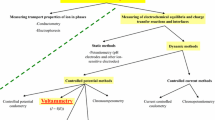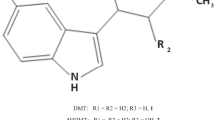Abstract
Shaking movements, similar to those made by a dog when wet, were elicited in rats by a) immersion in ice-water, b) injections of icilin, a chemical that produces sensations of cold, and c) naloxone-precipitated morphine withdrawal. Adenosine and 2-chloroadenosine produced dose-dependent inhibition of shaking to ice-water and icilin. The 2-chloroadenosine effect was mediated centrally because the ICV dose required to produce inhibition was not effective when given IP. Caffeine antagonized the inhibitory effects of adenosine and 2-chloroadenosine. 2-Chloroadenosine suppressed morphine-abstinence shaking as well as the body weight loss that normally accompanies withdrawal.
Similar content being viewed by others
References
Barraco RA, Aggarwal AK, Phyllis JW, Moron MA, Wu PH (1984) Dissociation of the locomotor and hypotensive effects of adenosine analogues in the rat. Neurosci Lett 48:139–144
Budohoski L, Challiss RAJ, Lozeman FJ, McManus B, Newsholme EA (1984) Increased insulin sensitivity in soleus muscle from cold-exposed rats: reversal by an adenosine-receptor agonist. FEBS Lett 175:402–406
Coffin VL, Taylor JA, Phillis JW, Altman HJ, Barraco RA (1984) Behavioral interaction of adenosine and methylxanthines on central purinergic systems. Neurosci Lett 47:91–98
Collier HOJ (1984) Cellular aspects of opioid tolerance and dependence. In: Hughes J, Collier HOJ, Rance MJ, Tyers MB (eds) Opioids: past, present and future. Taylor and Francis, London Philadelphia, pp 109–125
Collier HOJ, Tucker JF (1983) Novel form of drug-dependence — on adenosine in guinea pig ileum. Nature 302:618–621
Cserr H (1965) Potassium exchange between cerebrospinal fluid, plasma, and brain. Am J Physiol 209:1219–1226
Daly JW (1982) Adenosine receptors: targets for future drugs. J Med Chem 25:197–207
Dixon WJ, Massey FJ Jr (1983) Introduction to statistical analysis. 4th. ed., McGraw-Hill, NY
Dunwiddie TV (1985) The physiological role of adenosine in the central nervous system. Int Rev Neurobiol 27:63–139
Dunwiddie TV, Worth T (1982) Sedative and anticonvulsant effects of adenosine analogs in mouse and rat. J Pharmacol Exp Ther 220:70:76
Gibson RD, Tingstad JE (1970) Formulation of a morphine implantation pellet suitable for tolerance-physical dependence studies in mice. J Pharm Sci 59:426–427
Hamprecht B (1977) Structural, electrophysiological, biochemical and pharmacological properties of neuroblastoma × glioma hybrids in cell culture. Int Rev Cytol 49:99–170
Hollands MA, Cawthorne MA (1981) A simple apparatus for comparative measurements of energy expenditure in human subjects: the thermic effect of caffeine. Am J Clin Nutr 34:2291–2294
Issacson RL, Lanthorn TH (1981) Hippocampal involvement in the pharmacologic induction of withdrawal-like behaviors. Fed Proc 40:1508–1512
Janssen PAJ, Niemegeers CJE, Dony JGH (1963) The inhibitory effect of fentanyl and other morphine-like analgesics on the warm water induced tail withdrawal reflex in rats. Arzneimittel-Forsch 13:502–507
Katims JJ, Annau Z, Snyder SH (1983) Interactions in the behavioral effects of methylxanthines and adenosine derivatives. J Pharmacol Exp Ther 227:167–173
Levinger IM (1971) The cerebral ventricles of the rat. J Anatomy 108:447–451
Litchfield JT, Wilcoxon F (1949) A simplified method of evaluating dose-response experiments. J Pharmacol Exp Ther 96:99–113
Sherrington CH, Laslett EE (1903) Observations on some spinal reflexes and the interconnection of spinal segments. J Physiol (Lond) 29:58–96
Snyder SH (1985) Adenosine as a neuromodulator. Ann Rev Neurosci 8:103–124
van Calker D, Muller M, Hamprecht B (1979) Adenosine regulates via two different types of receptors, the accumulation of cyclic AMP in cultured brain cells. J Neurochem 33:999–1005
Wei ET (1976) Chemical stimulants of shaking behaviour. J Pharm Pharmacol 28:722–724
Wei ET (1981) Pharmacological aspects of shaking behavior produced by TRH, AG-3–5, and morphine withdrawal. Fed Proc 40:1491–1496
Wei ET (1983) Inhibition of shaking movements in rats by central administration of cholinergic and adrenergic agents. Psychopharmacology 81:111–114
Wei ET, Seid DA (1983) AG-3–5: a chemical producing sensation of cold. J Pharm Pharmacol 35:110–112
Wei ET, Sigel S, Loh HH, Way EL (1975) Thyrotrophin-releasing hormone and shaking behaviour in rat. Nature 253:739–740
Wei ET, Tseng LF, Loh HH, Way EL (1974) Similarity of morphine abstinence signs to thermoregulatory behaviour. Nature 247:398–399
Wei ET, Way EL (1975) Application of the pellet implantation techniques for the assessment of tolerance and physical dependence in the rodents. In: Ehrenpreis S, Neidle A (eds) Methods in narcotic research. Dekker, NY, pp 243–259
Williams M, Huff JR (1983) Adenosine as a neuromodulator in the mammalian central nervous system. Ann Rep Med Chem 18:1–9
Yesair DW, Branfman AR, Callahan MM (1984) Human disposition and some biochemical aspects of methylxanthines. In: Spiller GA (ed) The methylxanthine beverages and foods: chemistry, consumption and health effects. Alan R. Liss, New York, pp 215–233
Author information
Authors and Affiliations
Rights and permissions
About this article
Cite this article
Tse, S.Y.H., Wei, E.T. Inhibition of the shake response in rats by adenosine and 2-chloroadenosine. Psychopharmacology 90, 322–326 (1986). https://doi.org/10.1007/BF00179184
Received:
Revised:
Issue Date:
DOI: https://doi.org/10.1007/BF00179184




